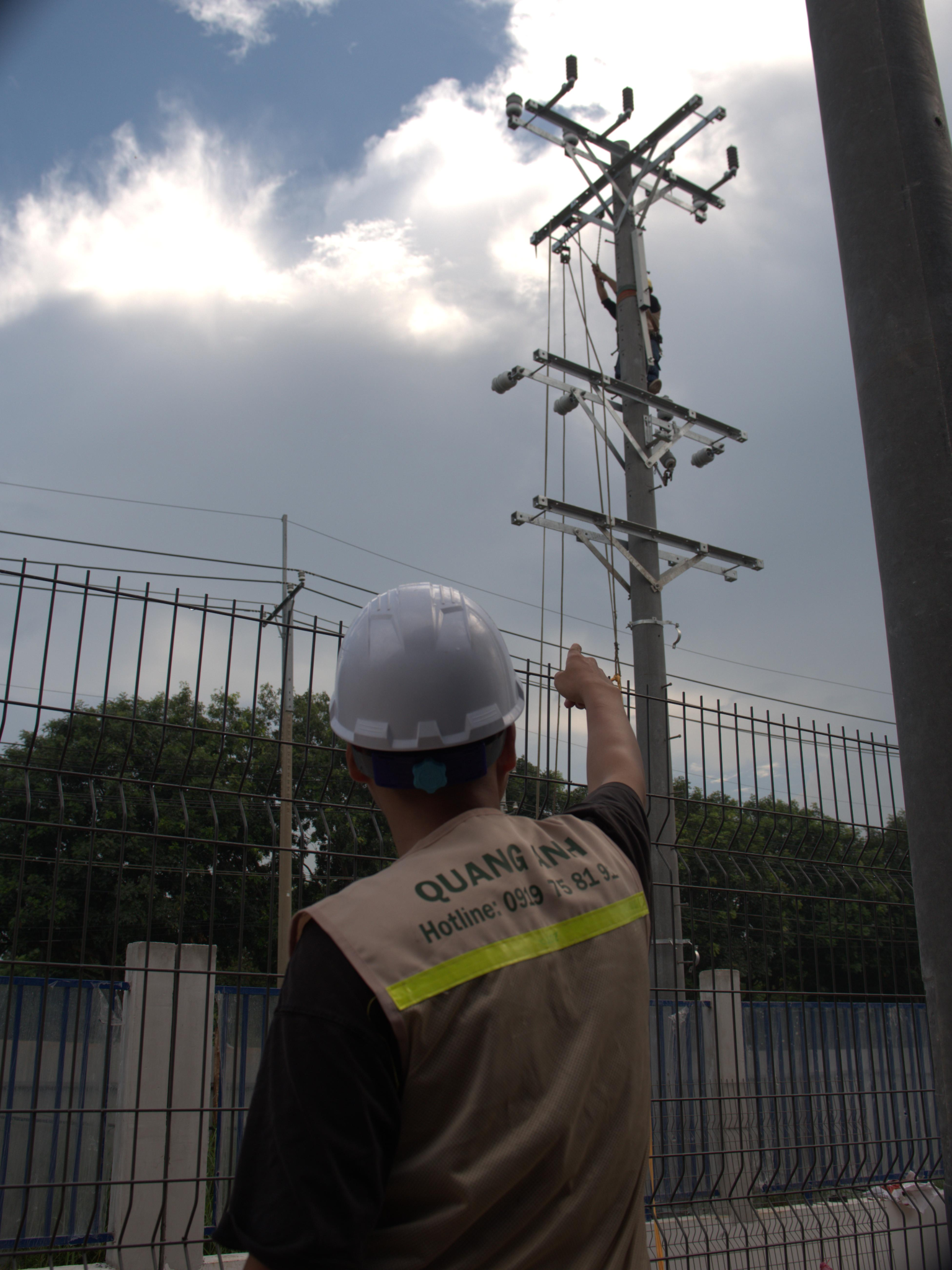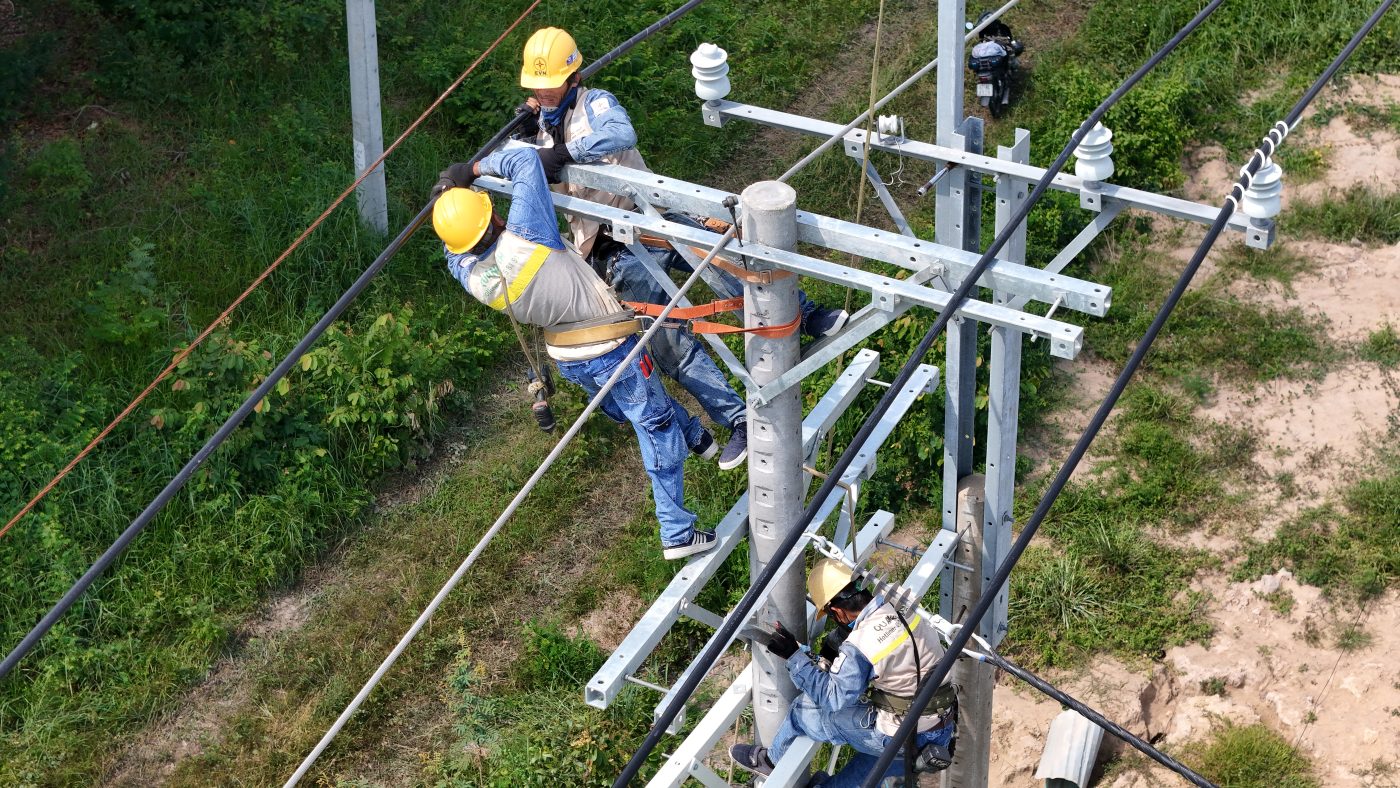Industrial electrical installation involves designing, installing, and managing electrical systems in factories and industrial zones to ensure stable and safe operations.
Overview of Industrial Electrical Installation
This process includes designing and setting up electrical systems that meet the needs of manufacturing facilities. These systems encompass electrical devices, power lines, substations, distribution cabinets, control, and automation systems to ensure industrial electrical safety and efficient energy usage.
Industrial electrical installation is a vital engineering field, involving the design, installation, and maintenance of industrial electrical systems. These systems are typically applied in factories, industrial zones, and large constructions, requiring a professional execution process to ensure both efficiency and safety.
Process of Industrial Electrical Installation
-
Site Survey
- The purpose of the survey is to gather detailed information about the construction, such as area size, devices that require power supply, and specific electrical needs.
- This information helps assess the electrical needs for lighting systems, air conditioning, manufacturing machinery, etc.
-
Technical Drawing Design
- Drawings must clearly illustrate all equipment installation positions, electrical circuits and adhere to both international standards and local regulations.
-
Equipment and Materials Preparation
- It’s crucial to prepare all necessary equipment like distribution panels, power cables, lighting systems, and other essential items.
-
System Installation
- Heavy electrical systems involve the installation of substations, distribution cabinets from brands such as Cadivi, LS, Eaton.
- Light electrical systems cover lighting installation, lightning protection, and building management systems.
-
Inspection, Acceptance, and Handover
- The inspection process ensures the system’s safety, no faults, and compliance with the design. Functionality acceptance and equipment testing should be conduct as per contract standards.
Key Technical Elements
- Ensuring electrical safety is the number one priority, involving the use of standard-compliant materials and devices.
- Design energy-efficient systems by employing LED lighting and high-performance equipment.
- Regular maintenance is necessary to keep systems operating smoothly and extend their lifespan.
Main Electrical Systems in Industrial Installation
The main electrical systems typically found in industrial installation include:
- Heavy Electrical Systems: Substations, distribution cabinets, generators, and water pumps.
- Light Electrical Systems: Lighting systems, lightning protection, and security camera systems.
Industrial electrical installation demands deep technical knowledge and strict adherence to safety regulations to ensure systems function reliably and efficiently after completion.

Process of Industrial Electrical Installation
The industrial electrical installation process starts with system design by engineers, followed by the preparation of materials and equipment. The project then proceeds with an on-site survey to ensure alignment with actual conditions, followed by the installation of components like protective conduits, power cables, and distribution panels. Finally, connections, inspections, and test operations make sure the electrical system functions safely and reliably.
Equipment Preparation & Site Survey
- Preparation of Materials and Equipment: Initial steps in successful industrial electrical installation include preparing necessary tools, materials, and electrical equipment that meet technical and safety standards. This involves using reputable brands like CADIVI and Schneider to ensure quality.
- Site Survey: This stage involves gathering client-provided information, conducting field surveys to assess the site, and agreeing on the installation plan with stakeholders. Accurate surveys serve as the basis for effective industrial electrical design.
System Design Drawings
- Creating Design Drawings: After gathering comprehensive data from the survey, engineers draft the industrial electrical system designs, including schematic diagrams, device layout, power calculations, and suitable cable selection.
- Plan Approval: The design plan is then presented to a technical board or investors for approval, with possible adjustments to match actual conditions.
Installation Execution
- Implementing the Drawings: Install the electrical system according to the approved drawings, ensuring considerations for position, height, spacing, and electrical safety are observed.
- Safety in Construction: Adhering to labor safety regulations and utilizing protective gear are crucial to avoiding accidents during construction.
- Quality Assurance: Conduct strict checks at each installation stage, using equipment from Thibidi and Mitsubishi to ensure long-term effective system performance.
Inspection, Testing & Acceptance
- Testing and Trial Operations: After completing installation, each connection point is inspected, running test operations on the entire system to ensure no issues like short circuits, fires, or leakage occur.
- Acceptance: The industrial electrical installation process concludes with a formal acceptance report, documenting points meeting technical requirements and handing over to investors or end-users.
Post-Installation Maintenance
- Regular Maintenance: To maintain operational efficiency, industrial electrical systems need regular inspections and maintenance.
- User Training: Instructing operational staff on using and maintaining the system is crucial for equipment longevity and safety.

Related Industrial Electrical Services
Beyond installing industrial electrical systems, related services include designing and setting up electrical and water systems, repairing and maintaining electrical faults, as well as implementing specialized systems like HVAC, ventilation, and lighting. These services ensure performance and safety for production facilities.
Definition & Scope of Industrial Electrical Services
Industrial electrical services provide comprehensive solutions for manufacturing facilities in designing, executing, and maintaining industrial electrical systems. This domain requires in-depth understanding of factory electrical systems and large industrial projects to ensure electrical safety, efficiency, and cost optimization.
Common Types of Industrial Electrical Services
- Designing Industrial Electrical Systems: This service includes calculations and preparing design plans to meet technical and safety requirements, optimizing electrical systems for any scale of factory or industrial park.
- Installation and Setup of Electrical Systems: Involves setting up switchboards, lighting systems, wiring, and devices like transformers and circuit breakers from brands like Thibidi, Mitsubishi, Schneider.
- Industrial Electrical Repair and Maintenance: Supporting routine maintenance, periodic inspections, and repairing electrical faults to upgrade and automate old systems.
- Installation and Repair of Inverters, Industrial Devices: Optimizing operation, saving energy for equipment.
- Consulting and Supervising Electrical System Installations: Ensuring that systems are constructed according to standards, with quality acceptance.
Features of Industrial Electrical Services
- Professionalism and Extensive Experience: Experienced technicians and engineers with industry-standard expertise.
- Ensuring Safety and Effectiveness: Meeting safety standards to prevent accidents and fire hazards.
- Cost-Effective Operations: Designing optimal systems to reduce energy cost and enhance production efficiency.
Development Trends in Industrial Electrical Services
- Adopting New Technology: Integrating automation systems, smart controls, and remote monitoring.
- Digital Transformation in Electrical Services: Using online platforms for easy customer access.
Benefits of Using Professional Industrial Electrical Services
- Minimize risks, increasing reliability of the electrical system.
- Reduce operational and maintenance costs over the long term.
- Ensure compliance with electrical safety regulations.

Industrial electrical installation plays a crucial role in enhancing efficiency and safety in industrial production. It offers technical benefits and builds long-term investment value for businesses.
Contact QuangAnhcons at +84 9 1975 8191 for consultation and support on industrial electrical installation.
QuangAnhcons provides design, installation, and maintenance services for industrial electrical systems, ensuring safety and operational efficiency for factory and industrial park projects.


Related Posts
Factory Electrical Systems: Comprehensive Design and Implementation Guide
Discover the detailed and safe process of factory electrical systems design and implementation. [...]
Oct
Blueprints Required for Factory Construction Permits
Discover the necessary blueprints in factory construction permit applications, from floor plans to electrical and [...]
Oct
What Are the Requirements for a Factory Construction Permit? A Comprehensive Guide
Explore the documentation and steps needed to secure a factory construction permit for streamlined project [...]
Oct
Factory Construction Permit Procedures in Vietnam: Essential Guidelines and Documents
Learn the procedures for securing a factory construction permit in Vietnam, focusing on document preparation [...]
Oct
Key Steps in the Factory Construction Process
Discover the essential steps and requirements for building factories. [...]
Oct
Comprehensive Electrical Substation Solutions by Quanganhcons
Discover the cutting-edge electrical substation solutions offered by Quanganhcons for industrial applications. [...]
Oct
Investment Costs for a 1MWp Solar Power System and Influencing Factors
Explore the investment costs for a 1MWp solar power system in Vietnam and the influencing [...]
Sep
QuangAnhcons: Elevating Wind Energy Solutions
Explore QuangAnhcons' leadership in wind energy and renewable solutions in Vietnam. [...]
Sep
Electrical Contractor Strategies at Becamex Industrial Park
Discover the strategic advancements and partnerships of the electrical contractor at Becamex Industrial Park. [...]
Sep
Investment Insights for 1MW Wind Energy in Vietnam: Costs and Opportunities
Discover the detailed analysis of costs and opportunities for investing in 1MW wind energy projects [...]
Sep
Advanced Electrical Installation Solutions by QuangAnhcons
Explore advanced electrical installation solutions and modern technology with QuangAnhcons. [...]
Sep
Enhancing Industrial Electrical Services with Quanganhcons
Discover Quanganhcons' expertise in industrial electrical services, offering efficient and sustainable power systems. [...]
Sep
Comprehensive MEP Solutions by QuangAnhcons: From Design to Maintenance Excellence
Discover optimal MEP solutions with QuangAnhcons, dedicated to excellence from design through maintenance. [...]
Sep
Comprehensive Electromechanical Contracting Solutions by QuangAnhcons
Explore QuangAnhcons' comprehensive services for efficient and safe energy system solutions. [...]
Sep
QuangAnhcons: Empowering Industrial Energy Solutions
Discover how QuangAnhcons delivers optimal industrial EPC solutions. [...]
Sep
Effective Industrial Construction Management and Execution
Optimize your industrial projects from design to execution with our contractor services. [...]
Sep
QuangAnhcons: Pioneers in M&E and Renewable Energy Solutions
Discover QuangAnhcons' innovative M&E services and renewable energy solutions. [...]
Sep
QuangAnhcons: Expertise and Outstanding Services in the Electrical Sector
Discover the unmatched expertise and services of QuangAnhcons, setting superior standards in the electrical contracting [...]
Sep
QuangAnhcons: Innovation and Precision in Industrial Electrical Contracting
Discover QuangAnhcons, a top contractor offering superior electro-mechanical solutions. [...]
Aug
Expert Solutions for 2x2500kVA Substation Projects with QuangAnhCons
Explore QuangAnhCons, a forefront entity in designing and constructing large industrial substations. [...]
Aug